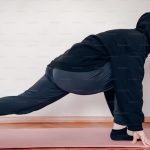I have said it before, and I say it again – shoulderstand is truly a thing of beauty. With the right combination of strength and flexibility, it can be elegance and grace personified. It is iconic and SO photogenic – a social media ‘go-to’ pose that all yogi’s want to be able to do from the moment they discover yoga. Nicknamed the ‘Queen of poses’ – shoulderstand is considered to be cooling; stimulates the calming (parasympathetic) side of the autonomic nervous system; and is reputed to assist in resolving a wide range of medical problems. It demands significant upper body and core strength plus beautifully open chest and shoulders – all wrapped up in a healthy dose of confidence in being upside down. So easy when you are a child – so much harder as an adult!
For most of us, the path to a passable shoulderstand is long and paved with patience, patience, and more patience. Months and years of preparation work may be needed – I have written about a few favourite preparatory poses that have served me well on my journey. That work is coming together now and my shoulderstand is starting to be recognisable. Not perfect, but presentable. So, now that I can get upside down and my body resembles a straight line what else do I need to work on? Maybe you are ready to work on this too … Here is what we need to do.
Neck Care Cautions
Some people are able to practice shoulderstand flat on the floor but that is a big ask in terms of neck range of movement and loading through the flexed spine in this way is not always comfortable. In response to his students getting neck problems after practicing shoulderstand, BKS Iyengar developed a modification where the shoulders and arms are raised on blocks or a folded blanket while allowing the head to rest on the floor. This reduces the range of neck flexion (bend) needed in the pose and encourages weight bearing through the shoulders and arms rather than the neck.
Whether you are using the modification above or not, the neck should be lengthening to create space between the chest and chin in a shoulderstand. And it should be comfortable, always comfortable.
Now is probably a good time to suggest that the full expression of shoulderstand may not be for everyone. Particularly if you have neck issues. Shoulder, arm or hand problems make it a challenge. Some sources recommend caution for people with high blood pressure or early in pregnancy too.
Cause no ‘arm
The hands are placed flat on the lower back as close to your shoulder blades as you can comfortably get them. Tucking your hands under your clothes to get good skin on skin contact makes everything more stable. Walk the elbows together until the upper arms are parallel while drawing the shoulder blades together. Press firmly through both elbows and keep squeezing the shoulder blades together as you grow tall through the whole length of the body from this lovely firm base on the upper arms. Working the arms like this also to reduce loading through the neck and makes the pose more comfortable.
Straight Up!
Using that wonderful firm base for grounding really helps you to lift the feet skywards too. You are aiming for the shoulders, pelvis, and feet to be in a straight line at 90 degrees to the floor – imagine they are all in contact with a wall behind you.
Drawing the toes towards the knees, lifting through the heels and striving to lengthen the back of the legs adds extra stabilising muscle action if you are striving for perfection.
Preparation and Modification
Patient, thorough preparation is vital before attempting the full expression of this pose. Use supported bridge (setu bandhasāna) and fish pose (matsyasāna) to warm up and strengthen the shoulders. Camel (ustrasāna) and wide legged forward fold (prasaritta padottanasāna) with hands on hips are great to open the chest and shoulders before attempting a shoulderstand maybe later in your practice.
Modifications also provide a step by step progression to the full majesty of a shoulderstand. Here are a few for you to try
- Raised shoulders – as mentioned above, placing 3 blocks in a line (long edges next to each other) then 2 more (short end to short end) across the top makes a rectangular platform one block thick for your shoulders. Alternatively, you can fold a blanket to make a similar-sized platform. Placing this platform under your mat is recommended in some styles. Lie with your shoulders level with the top of the platform and head on the floor before lifting your feet overhead. I recommend this modification if you have ever had any neck problems to prevent aggravating old inured AND if you have never suffered neck pain and don’t want to! It is a lovely modification.
- Feet on chair – if getting your feet overhead is too much initially, place a chair or stool above your head as you lie on your back so that you can lift your hips onto your hands then rest the feet back on to the stool. Placing the chair so that your hips can get right above your shoulders allows you to try lifting one leg up at a time into a sort of 3/4 shoulderstand with one leg and the body in a straight line and the other foot stabilising on the chair. This is lovely preparation for kicking off the chair into full shoulderstand at some point in the future.
- Feet on wall – for this one, lie with your legs up the wall. Bend your knees and place both feet flat on the wall about where your knees were. Press through your feet to assist in lifting hips then get arms in place as for shoulderstand. This is really stable and builds confidence side down if it seems a scary prospect.
- Half shoulderstand – lift the hips up onto the hands as for shoulderstand and take feet up towards ceiling but allow hips to stay closer to the floor than in the full expression with the hips remaining flexed. This is really nice for anyone who feels claustrophobic in the full expression of the pose or for the fuller figured yogi who gets a face full of boobs or belly when they go upside down.
For a pose that looks effortless when done well there is ALOT to concentrate on. There is a myriad of muscle actions all combined into the super shoulderstand that we seek. Be kind to yourself, mindful practice and persistence will pay dividends if you let them. Enjoy your path to upside-down utopia!













